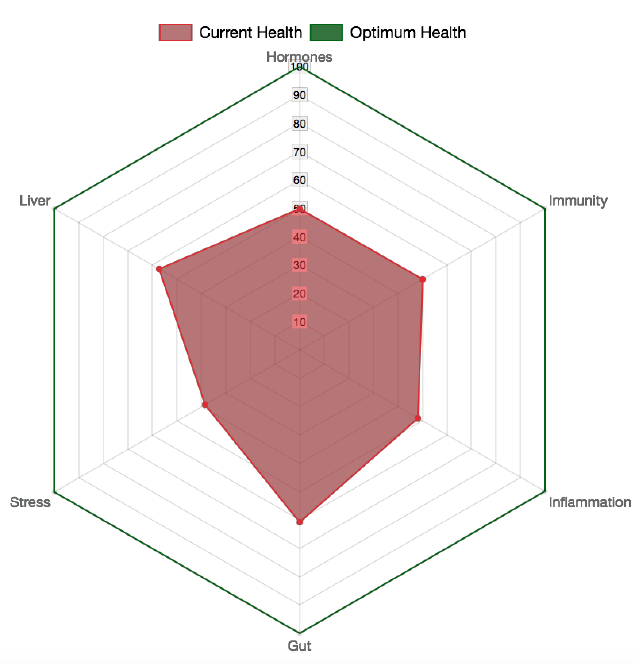ADHD – Root Causes and Natural Nutrition Solutions
Written by: Maria Allerton and Toni Chambers
ADHD (Attention Deficit Hyperactivity Disorder) is a neurodevelopmental condition. It is frequently diagnosed in children, but more adults are now receiving diagnoses of ADHD. It affects around one in 20 Australians, that’s about a million people, but as ADHD becomes more common, people are looking to nutrition and diet solutions and the root cause rather than medication.
You will find that ADHD is more commonly diagnosed in males than females and in childhood when attendance at school highlights difficulties, including physical restlessness, inability to concentrate and short attention span?1
Although I haven’t sought a formal diagnosis of ADHD for myself, over the past few years, I’ve noticed the signs and symptoms emerge daily and have looked back at my childhood. I can clearly see that this is something I’ve had all my life.
Living with ADHD can be very challenging for parents of ADHD kids, and there is often pressure to have the child put on medication. Whilst many kids and adults find that symptoms sometimes improve on medication, they don’t address the root causes and often have significant side effects, especially with long term use.
In clinic, we have a number of approaches for ADHD and see many child and adult clients with this condition.
Signs of ADHD and Symptoms
The ‘classic’ ADHD adult symptoms identified by psychologists include:
- Inattention
- Hyperactivity
- Impulsivity
Sometimes these traits are clearly evident and visible, and sometimes it can take time to realise that ADHD may be an issue that needs addressing.
I found that Dr Gabor Mate’s book “Scattered Minds” offers a much more in-depth and personal perspective on ADHD. Here are some characteristics and behaviours he describes from his personal and clinical experience and the ones I picked as strongly descriptive of my clients with ADHD and my personal experience.
This quote from Dr Mate’s book is a great summary of how it feels for adults:
“The shock of self-recognition many adults experience on learning about ADD is both exhilarating and painful. It gives coherence, for the first time, to humiliations and failures, to plans unfulfilled and promises unkept, to gusts of manic enthusiasm that consume themselves in their own mad dance, leaving emotional debris in their wake, to the seemingly limitless disorganisation of activities, of brain, car, desk, room. ADD seemed to explain many of my behaviour patterns, thought processes, childish emotional reactions, my workaholism and other addictive tendencies, the sudden eruptions of bad temper and complete irrationality, the conflicts in my marriage and my Jekyll and Hyde ways of relating to my children….. No longer mysterious was my ineptness following directions or even remembering them, or my paralytic rage when confronted by a sheet of instructions telling me how to use even the simplest of appliances.”
Can you relate? I certainly can and realised at 45 years of age that I’ve been this way my whole life😊.

ADHD is typically separated into three presentations:2
1. Hyperactive-impulsive
May include an inability to sit still in class or play quietly, excessive talking, trouble waiting for his/her turn, and often interrupting or intruding on others.
2. Inattentive
Inability to focus on details, follow instructions and appearing not to listen when spoken to directly.
3. Combined
Meeting the criteria for both hyperactive-impulsive and inattentive types.
Common symptoms of ADHD in adults and children include:
Lack of sense of time
Usually run late for appointments, work, meetings, school pick up- most things. The sense of time for an ADHD person is endless, and estimating it is actually really hard. My clients will know this from the frequent ‘sorry, running 10 mins late’ messages they receive from me before appointments quite often. For a person with ADHD, time has a very stretchy quality, and 10 mins feels like a huge amount of time to try and cram in more ‘to do’ stuff
Lack of focus
Often seen as ‘tuning out’ in the classroom for children and a short attention span, except if it’s something super interesting! Most people with ADHD procrastinate and don’t focus on the task at hand well. Until it’s something they find fascinating and engaging, then the focus is laser-sharp and obsessive, and nothing will divert their attention. To be able to focus, a person with ADD needs a much higher level of the neurotransmitter dopamine, which provides motivation, than other people.
For some, it’s a subject at school- a favourite subject that a child does really well in while struggling with the rest- often because the rest is just not that interesting.
For me, nutrition and everything that relates to health are hyper-interesting, so my focus on my work is laser sharp. In school, I hated all subjects in the field of science with a passion. It wasn’t until I had my own health issues and so did my kids that I became absolutely fascinated and focused on biology, chemistry, genetics and nutrition science.
My classic ADHD trait is reading 5-7 books at the same time and never finishing any of them (lose interest once I ‘got’ the gist). Then ordering more books online to read ‘later’ (impulsivity).
Impatience
A sense of urgency typifies ADD and the need to have everything ‘now’. This has been exacerbated for many in the current urgency culture of devices and endless emails.
Impulsivity with poorly controlled emotional reactivity
Often ADD kids and adults struggle to restrain themselves from interrupting others, find it hard to wait for their turn and often act or speak impulsively, often with negative consequences. Being a ‘class clown’ is a common feature of the ADHD child.
Hyperactivity
Often shows up as trouble keeping physically still, fidgeting or excessively talking. Some people do not exhibit hyperactivity. The mind of a person with ADHD is always in motion and is averse to boredom and a lack of stillness, and an inability to relax and ‘do nothing’.
Emotional regulation
While many people with ADHD are very bright, their emotional regulation skills are often poor. The emotional states of adults with ADD can go through rapid and unpredictable up-and-down swings.
Procrastination
The hyperactivity goes with procrastination. Dr Mate describes this well: “The restlessness coexists with long periods of procrastination. The threat of failure or the promise of reward has to be immediate for the motivation apparatus to be turned on. Without the rousing adrenaline rush of racing against time, inertia prevails”. Books half read, projects half finished, and courses begun and quit are all a feature of ADD.
The ADHD Brain
Brain imaging studies have revealed the presence of neurological dysfunction; while parts of their brain work as expected, cortical regions involved in attention, impulse control, and stimulus integration abilities, have yet to become fully active. As a result, people with ADHD suffer from overload. They have a heightened awareness of incoming stimuli, particularly sight, sound, and touch. They are so overwhelmed by the normal stimuli in their environment that they cannot filter out the background noise, leading to difficulty focusing or concentrating on a problem or a task. As a result, those with ADHD have trouble completing what they start. They have difficulties with making plans and even more difficulty methodically carrying out plans.1
This is the child with the messy room and the adult with a cluttered desk; their drawers and garages are filled with partly finished projects as they lose interest halfway through. They tend to be impatient and intolerant of change. They can be impulsive, often acting without considering the consequences. They may have trouble differentiating their right hand from their left; they may have difficulty following a set of instructions, reading a map, or telling time. As adults, they are restless, easily bored, rebellious when asked to follow a routine, and always on the move. 1
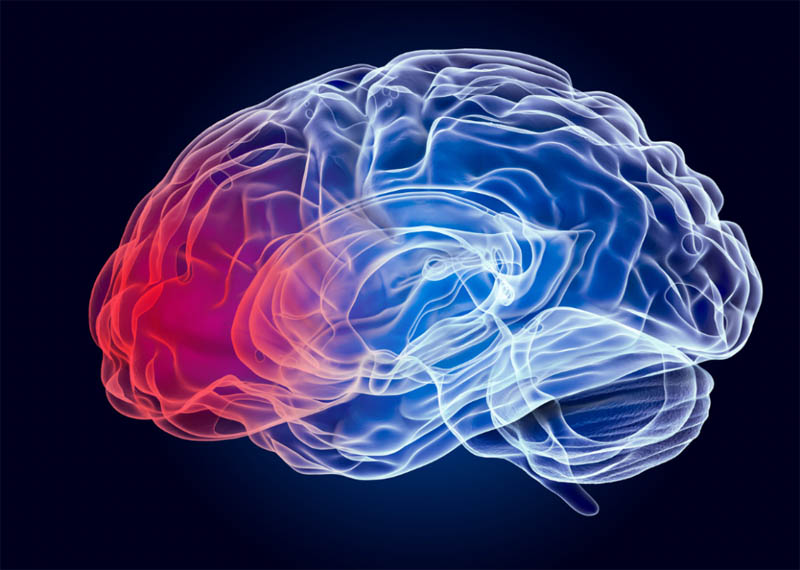
Causes of ADHD
The causes are complex and involve genetics, toxicity, nutrient deficiencies and often trauma or excessive stress. As with most health conditions, it is recognised that there are genetic as well as environmental influences on its development.
Genetics
A staggering 1800 studies have looked at the link between ADHD and genetic factors. As a result, we have strong evidence that genes play a role in a person’s susceptibility to developing ADHD. In fact, it’s believed that genes account for 70-80 percent of a person’s risk.3
This is where the certainty ends, though, with many genes implicated but very few consistently found to be the cause of ADHD across-the-board. Among those uncovered are genes affecting the central nervous system transport of dopamine, norepinephrine and serotonin, as well as neuronal plasticity (the ability of the nervous system to modify itself as needed).4
The interplay of genes and the maternal and paternal environment begins in utero to produce a neurobiological susceptibility, with structural, functional and molecular brain changes and, subsequently, ADHD occurring as a result.5 For example, structural imaging studies show that the brains of these children are significantly smaller than unaffected controls.6 Some pre and postnatal influences on neurobiology include the use of alcohol, tobacco, marijuana and prescription medication, as well as maternal stress and obesity, premature birth and low birth weight. 6
Other drivers for the development and persistence of ADHD can include
- Dopamine receptor and transport gene issues resulting in dopamine deficiency (I often see these on 23andme gene reports of clients and call these the ‘D’ SNPs: dopamine receptor polymorphisms (SNP stands for single nucleotide polymorphism or let’s call them ‘glitches’)
- Serotonin deficiency
- Increased brain levels of glutamate
- Mast cell activation
- Environmental factors, including nutritional deficiencies, food sensitivities and heavy metal exposures
- Inflammation and oxidative stress
- Emotional and physical stress
- Trauma
Not only do genes interact with the environment to produce physical brain changes, but those physical changes and gene SNPs impact serotonin and dopamine as they are heavily involved, and both interact closely together.
Studies report that in people with ADHD, there’s a 25% reduction in the binding capacity of serotonin transporters, with functional changes causing modifications in their expression and function. This affects the synthesis, clearance and metabolism of serotonin, leading to chronic serotonin deficiency. Studies looking at the neurological anatomy suggest that serotonin may regulate behavioural domains of hyperactivity and impulsivity in ADHD.7
Dysregulation of the dopamine transporter protein results in higher numbers of these transporters and a greater clearance of dopamine, meaning less dopamine available in the brain. Dopamine is responsible for emotional regulation and taking action in order to achieve a reward.1
There are also SNPs in genes for enzymes that convert the amino acid tryptophan to serotonin and dopa to dopamine, resulting in further neurotransmitter deficiencies.5
Other SNPs have been reported with links to antisocial behaviour and lower grey matter volume in children with ADHD; these children displayed more aggression and antisocial behaviour.5
In clinic, we regularly conduct gene testing to understand the unique underlying genetic glitches that may be impacting your unique ADHD picture because many genes and their functions are modifiable with nutrients and supplements. So even though there is a big genetic platform with ADHD, there is a lot that can be addressed through the right nutrition.
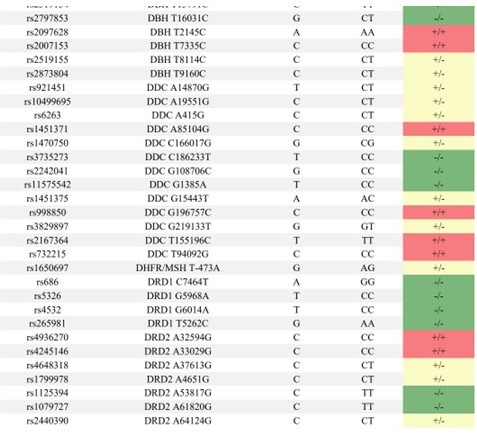
Example of gene report with dopamine conversion and dopamine receptor SNPs (glitches)
Inflammation
In ADHD, increased inflammation heavily influences the way excitatory neurotransmission occurs, with changes in kynurenine pathway metabolites closely associated with ADHD symptoms. The kynurenine pathway is the inflammatory pathway serotonin can take when there is dysfunction, changing the way serotonin (and melatonin) is synthesized.
In the presence of inflammation and elevated stress hormones such as cortisol, tryptophan is shunted away from the production of serotonin and metabolised to the neurotoxin quinolinic acid. Essentially when it moves down this pathway, it reduces the levels of much-needed serotonin.5 Animal studies have shown these metabolites act directly on glutamate receptors causing substantive increases in its release. Glutamate is one of our excitatory neurotransmitters, causing the symptoms relevant to ADHD: restlessness and difficulty concentrating.5
Adding further fuel to the fire, inflammation decreases biopterin, a cofactor for the function of an enzyme that produces serotonin and dopamine, further exacerbating their deficiency.
There are also negative effects on the expression of Brain Derived Neurotropic Factor (BDNF) within the brain, which leads to deficits in neuroplasticity – the ability of the nervous system to perceive, respond and adapt to stimuli – essential for learning and memory. This has additional consequences for neurogenesis (the formation of new nerve cells) and, therefore, cognition.
Inflammation can come from many sources, the most common being: mould exposure and toxicity, heavy metals, bacterial overgrowth in the gut and leaky gut. Having a leaky gut usually leads to having a ‘leaky brain’ which leads to brain inflammation.
In clinic, we use Organic Acids Testing to check serotonin, dopamine and their metabolism, as well as assess any kynurenine pathway dysfunction. This test is also fantastic for identifying mould and bacterial toxicity and overall toxic load. Below is an example of neurotransmitter test results from Organic Acids test of an ADHD individual:
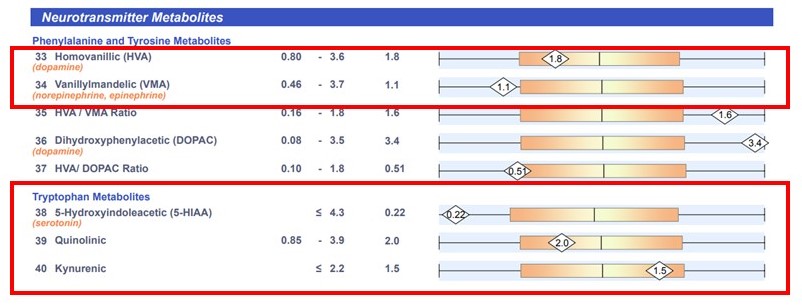
Nutritional deficiencies most common in ADHD
Iron
Studies show that iron storage and ferritin are low in people with ADHD and can exacerbate symptoms such as fatigue and Restless Legs Syndrome.9 Iron is vital in the production of dopamine and serotonin as well as thyroid function, all of which are critical in ADHD. Blood testing for iron studies is essential.
Vitamin D
Can increase the risk of developing ADHD and exacerbate symptoms.10 Vitamin D deficiency is extremely common even in ‘sunny’ places like Australia and, most definitely, in the UK and North America.
Zinc
Deficiency is common in ADHD, and the issues that go with it, such as depression and anxiety9, and raised copper: Zinc ratios contribute to risk and severity.11 This is a very common imbalance and is also linked to Pyroluria– more on this below.
Omega-3 Fatty Acids
Omega-3 fatty acids are deficient in those with ADHD.12 Omega 3 fatty acids, especially from oily fish such as sardines (which are lower in mercury than bigger fish), are very important to keep inflammation under control as well as directly positively influence the brain.
Magnesium
Very commonly deficient in the hyperactive subtype.9 Magnesium deficiency is so widespread some estimate that 90% of the population is chronically deficient. I find that the vast majority of our ADHD child and adult clients improve dramatically on magnesium supplementation. Incidentally, magnesium helps us manage blood sugar and stress, which are such prominent features of ADHD.
Copper dysregulation
Both copper toxicity and deficiency impact dopamine levels, so it is very common to see this factor today. I wrote a blog on Copper Toxicity HERE.
Other influences on the ADHD child or adult include:
- Poor diet that includes refined sugars, preservatives, colours and additives
- A diet and an environment that causes acidity in the body
- Poor digestive function as evidenced by constipation/diarrhoea and/or low appetite
- Exposure to a myriad of environmental toxins including mycotoxins (the toxins produced by mould in water damaged buildings)
- Pesticides and chemicals in food and personal care products
- Heavy metals such as mercury, lead, cadmium and arsenic, which we routinely see on Hair mineral analysis tests
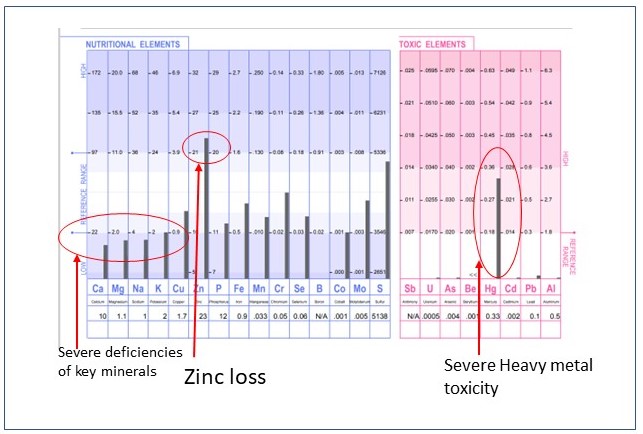
ADHD and its link with Pyroluria
ADHD has a lot of crossovers with Pyroluria/Pyrrole disorder. I’ve written extensively on Pyroluria disorder signs and symptoms along with recommended Pyrrole disorder diet recommendations.
Due to the zinc and B6 loss that occurs in Pyroluria, the production of both dopamine and serotonin is compromised, leading to the symptoms we commonly see in ADHD described above.
Anyone diagnosed with ADHD should consider a Pyrrole test and a Hair mineral analysis as a starting investigation into the root causes.
Food sensitivities and intolerances
People with ADHD often also suffer from gastrointestinal and immune dysfunction. Many also suffer from both Th1- and Th2-mediated conditions like:
- ear infections
- asthma
- eczema
A common pathophysiological mechanism has been suggested to underlie both asthma and ADHD, while several genes that are linked to ADHD have immune functions.8
In clinic, we see many kids and adults with ADHD who struggle with histamines and/or salicylates and other food sensitivities. Most of these arise from poor microbiome and poor liver clearance of these compounds due to poor methylation (detox) and glucuronidation pathways of the liver. Gene testing can be helpful here again to look at genes such as COMT, MTHFR, UGT1A1 and other liver detox pathways related genes.
The gut brain axis
Evidence suggests that the gut-brain axis is heavily influenced by the health of the microbiome. That microbiome may have been affected from birth with the use of proton pump inhibitors for baby reflux, antibiotics, especially prior to three years of age and bottle feeding.
Neurotransmitters directly affecting dysfunctional behaviours in those with ADHD are produced either directly or indirectly by the gut microbiota. In clinic, we regularly use microbiome testing to determine both the levels of ‘good/bad’ bacteria as well as overall gut function, such as the production of digestive enzymes, the presence of leaky gut and much more.
An example of poor ‘good’ gut flora in an ADHD child:

Sleep and ADHD
Sleep can be compromised by neurotransmitter and nutritional deficiencies, excess glutamate in the brain and neuroinflammation. Improving these underlying factors and subsequent sleep quality can improve neurological functioning, including impulse control, memory and attention.13
Stress and Trauma
I believe that one of the huge drivers of the ADHD epidemic we have today is excessive stress and unresolved trauma. Stress underpins most physical dysfunctions described above: it makes us lose calming minerals and vitamins like Magnesium, B6, zinc, and B vitamins. It lowers our stomach acidity (hydrochloric acid), leading to poor protein absorption and poor absorption of iron, zinc and B12 – the absolutely fundamental blocks of the formation of serotonin and dopamine. Stress impacts sleep quality resulting in the lowering of these neurotransmitters and gut dysfunction. Dr Mater discusses the impact of family dynamics, stress and trauma in the ‘Scattered Minds’ book in detail.
Addressing stress is one of the key strategies of our approach to ADHD.
Our ADHD child specialist and adult ADHD specialist can help
In our clinic, Toni Chambers specializes in ADHD in children, and Maria Allerton focuses on adults with complex ADHD and other conditions.
We take a detailed case history and discuss testing priorities to determine triggers and underlying issues to develop a comprehensive, individualised treatment plan. We often:
- investigate important nutritional deficiencies via Hair Tissue Mineral Analysis (HTMA) and/or blood testing
- determine the presence of toxic metals and heavy metals via HTMA
- thoroughly assess diet and potential environmental triggers
- determine food triggers via Food Sensitivity Testing
- conduct comprehensive microbiome testing via stool sampling to determine gut function, presence of pathogens and microbiome diversity
- conduct genomic testing
- determine neurobiological involvement, neurotransmitter deficiencies and the presence of mycotoxins via Organic Acids Testing
Everyone’s ADHD journey is unique and requires addressing the multiple factors discussed here.
How we can help
- Book a consultation.
- Check out our gut healing program, “Healing IBS Naturally” to begin your journey of gut restoration and food elimination/re-introduction to determine your unique food triggers and begin healing the gut and the brain.
References
- Blum K, Chen AL, Braverman ER, Comings DE, Chen TJ, Arcuri V, Blum SH, Downs BW, Waite RL, Notaro A, Lubar J, Williams L, Prihoda TJ, Palomo T O-BM. Attention-deficit-hyperactivity disorder and reward deficiency syndrome. Neuropsychiatr Dis Treat. 2008;4(5):893-918. https://www.ncbi.nlm.nih.gov/pmc/articles/PMC2626918/
- Radnegde K. ADHD in Australia : an overview of diagnosis and treatment. Aust J Pharm. 2020;101(1194):77-81.
- Committee PGCC. Genomewide association studies: history, rationale, and prospects for psychiatric disorders. Am J Psychiatry. 2009;166(May):540-556.
- Zhou K et al. Meta-analysis of genome-wide linkage scans of attention deficit hyperactivity disorder. Am J Med Genet Neuropsychiatr Genet. 2008;147B(December 5):1392-1398.
- Yadav SK, Bhat AA, Hashem S, et al. Genetic variations influence brain changes in patients with attention-deficit hyperactivity disorder. Transl Psychiatry. 2021;11(1). doi:10.1038/s41398-021-01473-w
- Curatolo P, D’Agati E MR. The neurobiological basis of ADHD. Ital J Pediatr. 2010;36(1):79.
- Banerjee, Emili, Nandagopal K. Does serotonin deficit mediate susceptibility to ADHD? Neurochem Int. 2015;82(March):52-68. https://www.sciencedirect.com/science/article/abs/pii/S0197018615000212
- Verlaet AAJ, Noriega DB, Hermans N, Savelkoul HFJ. Nutrition, immunological mechanisms and dietary immunomodulation in ADHD. Eur Child Adolesc Psychiatry. 2014;23(7):519-529. doi:10.1007/s00787-014-0522-2
- Villagomez A, Ramtekkar U. Iron, Magnesium, Vitamin D, and Zinc Deficiencies in Children Presenting with Symptoms of Attention-Deficit/Hyperactivity Disorder. Children. 2014;1(3):261-279. doi:10.3390/children1030261
- Johnson SR, Zelig R, Parker A. Vitamin D Status of Children with Attention-Deficit Hyperactivity Disorder. Top Clin Nutr. 2020;35(3):222-239. doi:10.1097/TIN.0000000000000202
- Skalny A V., Mazaletskaya AL, Ajsuvakova OP, et al. Serum zinc, copper, zinc-to-copper ratio, and other essential elements and minerals in children with attention deficit/hyperactivity disorder (ADHD). J Trace Elem Med Biol. 2020;58(March):4-6. doi:10.1016/j.jtemb.2019.126445
- Lachance L, McKenzie K, Taylor VH, Vigod SN. Omega-6 to omega-3 fatty acid ratio in patients with ADHD: A meta-analysis. J Can Acad Child Adolesc Psychiatry. 2016;25(2):87-96.
- Gregory AM, Agnew-Blais JC, Matthews T, Moffitt TE, Arseneault L. ADHD and Sleep Quality: Longitudinal Analyses From Childhood to Early Adulthood in a Twin Cohort. J Clin Child Adolesc Psychol. 2017;46(2):284-294. doi:10.1080/15374416.2016.1183499
- Gabor Mate MD, “Scattered Minds”








